Do you love superhero movies, but can admit you’ve never read a comic? Does the world of comic book collecting seem daunting, with thousands of issues and geek-filled stereotypes aplenty? Worry not, for many years comic books have been collected in nice, neat collections. Graphic novels usually reprint long-form storylines that have appeared over the course of the nearly 80 years of superheroes. These recommendations are geared toward people new to reading comics, but they’re sure to please any superhero fan. This order is essentially ascending in what new readers will likely find accessible. Of course, order doesn’t matter, just seek whatever might sound most interesting to you.
Marvels (story by Kurt Busiek, art by Alex Ross)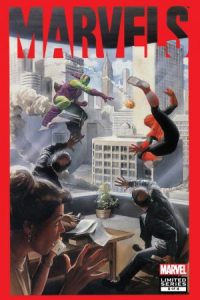
If the name doesn’t give it away, this collection is about characters from Marvel Comics. There’s a bit of a twist though, the story follows an ordinary man as he photographs and chronicles the emergence of superheroes in what was once the ordinary world. There is a powerful human element to this overall story—as in, it’s both marveling and frightening to be a human in a world of superheroes. The story shows what people are doing during events like, say, the arrival of a being so powerful it’s planning to eat the entire planet. It also gets down to the knitty-gritty—showing brawls between heroes and villains. You’ll get to see many heroes appear in the pages, but there is a greater focus on Sub-Mariner, Human Torch, The X-Men, Fantastic Four, and Spider-Man’s most famous and most devastating battle. If all this doesn’t sound enticing enough, then there’s the art. The book is painted in beautiful detail. The book looks pretty close to realistic, and the story feels even more real.
 Batman-The Dark Knight Returns (art and story by Frank Miller)
Batman-The Dark Knight Returns (art and story by Frank Miller)
This book is quite possibly the highest praised as far as Batman stories go. It has had immense influence on the character, and aspects of the book have appeared in movies and animation. In fact, there is a full-length animated movie, though check out the graphic novel first as it’s a really exciting read. Of course, this isn’t exactly traditional Batman. Frank Miller wanted to restore some of the clout that a spandex wearing Adam West had brought to the character. The novel takes place in Batman’s future. Bruce Wayne is getting old. The world has been corrupted by politicians. Crime runs rampant in Gotham City. Batman is retired, or, he’s supposed to be. The book brings readers along as Batman/Bruce Wayne can’t ignore who he truly is. The art is dark, and the story is full of allegory that has more of an 80s approach, but is still pretty pertinent nowadays too.
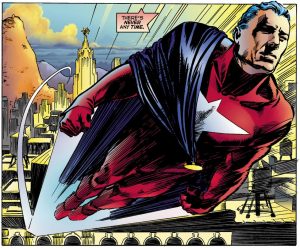 Astro City Volume 1 (story by Kurt Busiek)
Astro City Volume 1 (story by Kurt Busiek)
Never heard of Astro City? If you’re not into comics, you probably haven’t. This is a good thing: new readers can experience a comic-book world where they know absolutely nothing about the established lore. This original six-issue story came and went in the mid-90s. The quality of these comics eventually led to other volumes, and an ongoing series later. In the first volume, each issue is a standalone story. One could read the issues in any order without a hitch. Think of Astro City more like reading a collection of short stories rather than a novel. The stories are more character than plot-driven. Astro City is a unique collection in the world of comics, and it’s extremely accessible to any new reader.
Kingdom Come (story by Mark Waid, art by Alex Ross)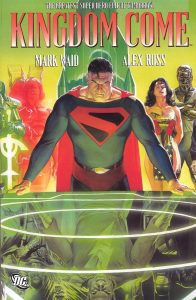
The ideals of the traditional superhero clash here with a new generation of super-powered beings. Once again, Alex Ross lends his talented paint brush to the comics. The story takes place in the future for the characters, or at least, it might be an alternate future. Characters like Superman, Wonder Woman, Batman and Green Lantern, struggle to keep up in a world where super-beings and corruption rule. It’s a case of traditional versus new. D.C. characters have been around a long time after all, and this storyline feels like a culmination of taking what is at these iconic character’s core, and seeing if it is still relevant in a changed world. Originally released in 1996, the comic world was drastically changing in the 90s—with new heroes and often violent comics popping up. Anyone who is old enough to recognize generational shifts will probably especially appreciate this comic.
X-Men: The Dark Phoenix Saga (story by Chris Claremont, most art by John Byrne)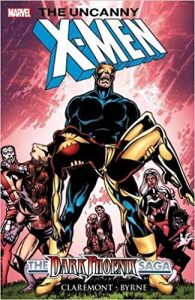
X-Men comics were Marvel’s most popular through the 80s and 90s. The characters were especially well-written by writers like Chris Claremont. The Dark Phoenix saga is one of the X-Men’s most epic stories. This collection begin within the continuity of the ongoing comics, but it’s accessible to new readers. Within the first pages, a new character is introduced that helps readers get up to speed. Action starts pretty quick, and what makes this story so special are the high-stakes and emotion. The X-Men have to decide what to do with a threat to the whole world, perhaps universe, who also happens to be one of the most beloved members of the team. By the way, the movies will never get this storyline right. Even if this story takes some time to feel caught up with, stick with it. The tragic story of Dark Phoenix is definitely worth sinking into.
Watchmen (story by Alan Moore, art by Dave Gibbons)
This story was originally a limited series that ran in the 80s and had high regard in the world of comics. As superhero movies became common, it seemed a sure fit for a cinematic tale. The movie was pretty faithful to the original content. Still, comics can capture a feel that movies cannot, and the world of Watchmen really tackles the act of super-heroing in general. What does it truly take to become a hero? Must one be crazy, be a killer, have great wealth or some sort of power. If you’ve forgotten what happens in the movie, then this story will be even better. A large part of the plot is essentially a mystery. One of the best things about this book is that the world of Watchmen feels as large as the worlds of Marvel or D.C., all while only needing to show a reader the tip of the iceberg.
The Tick: The Naked City (story by Ben Edlund)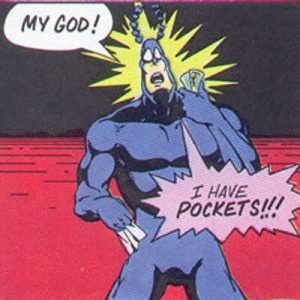
So many comics are just so dark and serious. The Tick comics were created by a teenager who worked at a comic store. Despite small print runs of early issues, The Tick became the superhero no one was asking for, but that the superhero-world really needed. The Tick is satire. Still, it takes the idea of superheroes serious enough that Tick stories not only caught on in comics, but found success on TV. The Tick has gotten three TV adaptations. If you like any of these shows, you really ought to check out the original Tick comic story. Actually, even if you haven’t seen the shows, check out this Tick anthology anyway. The stories in the original comics differ enough from show adaptations, and they have a great subtle humor to them. The Tick has become a mainstream hero because he is simply a lot of fun.
 Old Man Logan (story by Mark Millar, art by Steve McNiven)
Old Man Logan (story by Mark Millar, art by Steve McNiven)
Anyone who has seen some of the Marvel movies will find something to enjoy in this collection. The story, like others on the list, is an episode in a potential future. Villains rule the planet and Wolverine is one of the few superhero survivors. He gets a rather daunting task and has to travel across the country with a blind Hawkeye—who ironically happens to drive them. One of the more interesting aspects of the story are remnants of dead heroes. Enough time has passed that superheroes have become the stuff of lore. Readers get to see all sorts of signs of former Marvel superheroes. Imagine a road trip across the country with bits and pieces of old heroes—sometimes literally—scattered like roadside attractions, and you pretty much get the gist. The lore of the world is just so fantastic, and you have to see it to truly enjoy how cool it all is. (There have been sequels to this story, so make sure to read the original.)
Superman/Action Comics (story by Jerry Siegel, art by Joe Schuster–there are different versions of early collections of Superman. Just make sure to get Action comics number 1 in there.)) 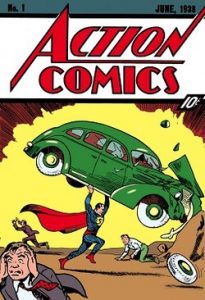
Who was the first super-powered superhero? Of course, it was the Man of Steel, The Last Son of Krypton: Superman. These original comics laid the groundwork for all superheroes that followed. And the groundwork is probably a lot different than one might guess. For example, Superman doesn’t even fly in the first issues. He seems to hop, or kind of like, skip as he travels about. His powers were a bit different and so were societal norms. These came out in the thirties after all. Lois Lane isn’t quite as confident and strong-willed as she became much later. The art wasn’t quite as advanced either. Yet, these stories have such a historical importance for their influence on the whole ensuing genre that was born from the introduction of Superman.
Well, I hope you enjoy the list. Feel free to make a comment and recommend some other books, or let me know what you thought of these.